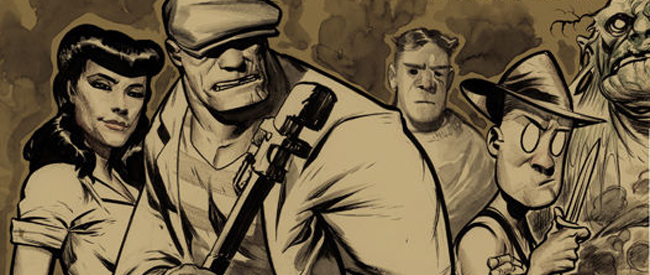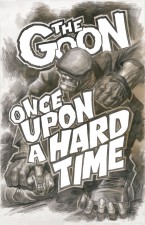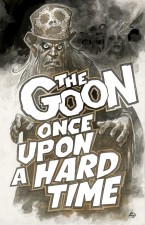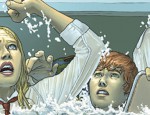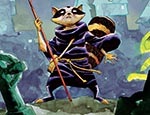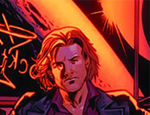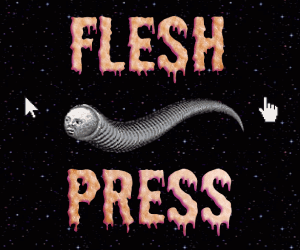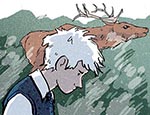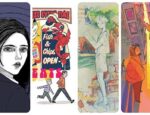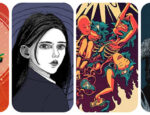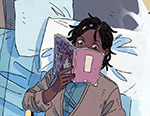For over 15 years Eric Powell’s name has been synonymous with The Goon. It’s the name of the character he created and whose adventures he’s been writing and drawing since the first self-titled miniseries came out from Avatar Press in 1999. When The Goon eventually made the move to Dark Horse, it had an impressive 44-issue run before Eric decided to end the regular series numbering in favor of a return to the miniseries format.
The first of these miniseries was ‘Occasion of Revenge’, which saw some pretty major shake-ups in the Goon world and set up the events for the next series, ‘Once Upon A Hard Time’, which will have major consequences for the main character, as well as his supporting cast. In fact, Eric says it may be the last story entitled ‘The Goon’ that he ever does.
With a possible end of The Goon in sight and plans for a new creator-owned series published by Image Comics on the horizon, Eric Powell sat down with us to discuss just what to expect from him in the future.
The Goon had a very impressive 44-issue run at Dark Horse Comics. What made you decide to end the regular series in favor of doing separate miniseries?
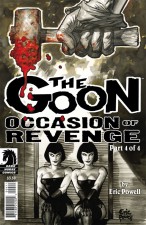 Eric Powell: Well, I’ve been doing the book mostly by myself since it started. I had Dave Stewart come in and do colors for a little while, but for the most part it’s just been me. Anytime I had to jump off of it for other projects or anything like that, or if I just had to take a break, it became kind of confusing for readers.
Eric Powell: Well, I’ve been doing the book mostly by myself since it started. I had Dave Stewart come in and do colors for a little while, but for the most part it’s just been me. Anytime I had to jump off of it for other projects or anything like that, or if I just had to take a break, it became kind of confusing for readers.
I guess with the monthly format of comics, people have an expectation that if it comes out a little sporadically then there’s something wrong with it. For the most part, we tried to have it on a bimonthly schedule, but I did have to take breaks here and there. And it just became really confusing to people. People didn’t know when the book was supposed to be coming out and the miniseries format just made sense.
I wish we had gone to it earlier because that way I can do four books, put up the solicitation, those four issues come out, and there’s an expectation of them being there. People know when it’s coming. It just made more sense.
So you’ll use the time in-between to make sure the entire miniseries is ready to go and to come out monthly?
Yes, that and to work on other projects. And I’ll do some random one-shots here and there. I want to keep The Goon out there but I have a lot of stuff I want to do and a lot of other projects I want to work on. So I want to keep The Goon relevant and out there and leave some time to get to the other stuff as well.
One of the other projects you’ve been working on is your writing gig on Big Trouble in Little China. Do you try to maintain a balance between working on creator-owned material and work for hire?
Yeah, I do. I try to. I definitely focus more on the creator-owned stuff. When a work-for-hire job comes along that I feel I could do a good job at and I think I would have fun with, I try to work it in there because it keeps it interesting and it presents different challenges for me. I’m a big fan of Big Trouble in Little China, so when the opportunity came to write a series, I jumped at it.
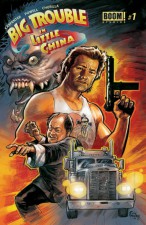 Typically, when you write a story, you know that you’ll be the one drawing it. What’s it like handing off the script and seeing what another artist does with it?
Typically, when you write a story, you know that you’ll be the one drawing it. What’s it like handing off the script and seeing what another artist does with it?
It’s a little difficult because, as an artist, you write something the way you would have drawn it. So you have to learn to let it go a little bit and realize that that’s their interpretation and you have to let them go with it. Luckily, I’m working with a really good artist, Brian Churilla. He’s been doing some really good stuff.
It’s almost like writing a script for a director and he’s going to put his vision into it, and hopefully you get a good one and even if their vision is different from yours, you can see what they’re doing with it still works. It tells the story.
Did you feel similarly during that year when you brought Dave Stewart on to do the colors for The Goon?
Well, Dave Stewart is such a good colorist that I rarely even gave him any kind of feedback. For the most part, he would turn in an issue and I would go, “Great!” Unless I had something very specific in mind for a scene or something, I’d just let him go with it. Of course, he’s one of the best colorists in the business, so that would be easy to do.
You use a lot of different material to create tones in The Goon, including pencils and ink wash. Did you maintain that process while working with Dave Stewart?
Yeah, I did all the same stuff. I may not have been as heavy handed as I do when I’m coloring my own stuff, like I’m doing now when I’m controlling the colors and everything. Because I’m letting more of that stuff – the pencils and the washes – take the place of some of the coloring.
With Dave, I did the same thing, but I held back a little bit so he would have some more positive area to work with. And it really only took us one issue to get in a rhythm. I gave some notes back on the first issue and from there on he really nailed it. He did a good job of taking the washes and stuff that I had done and adding just enough color to it, and the right temperature of color, depending on lighting or mood or whatever, making it warmer or cooler. Yeah, he’s just got great instincts when it comes to that stuff.
I noticed in ‘Occasion of Revenge’ that you changed your approach a little bit. Some of the pages were completely black and white, while others had a very simple, but bright, color scheme. Was that something you did to fit the mood of the storyline?
I was trying to lend a little bit of impact to different areas of the story where the main body of the story was mostly black and white with little hints of color here and there. But when I wanted there to be some kind of real emotional impact, I put a little more color into it. And in some places I cut out all the tones and washes altogether and just put color.
‘Occasion of Revenge’ ended on a very dark note, with serious implications leading into ‘Once Upon a Hard Time’. Are there major changes in store for The Goon going forward?
Yeah, if you look at The Goon from the very first issue up til now as one big story arc, this is going to be the end. I think I’m going to continue to do The Goon probably my whole life, but this is a big ending.
I have a lot of stuff planned. I’ve been plotting out the next arc I want to do. We don’t have it on the schedule yet, but we’ll see what happens. I’ve got a few things, key projects I want to get done. It won’t be a huge break, but there will be a gap before the next miniseries.
I noticed in the solicitations that the story in issue #2 of ‘Once Upon a Hard Time’ is inspired by the work of legendary SF/fantasy author H.G. Wells. What can you tell us about that?
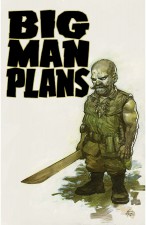 I don’t want to give it away, because I’m doing a kind of weird twist on the story, but I’m kind of, in a weird way, collaborating with H. G. Wells on this issue. I’ll tell you that the title of the story is ‘Man Turned Animal’, so that’ll give you a little bit of a hint as to where the end of this second issue of ‘Once Upon A Hard Time’ is going.
I don’t want to give it away, because I’m doing a kind of weird twist on the story, but I’m kind of, in a weird way, collaborating with H. G. Wells on this issue. I’ll tell you that the title of the story is ‘Man Turned Animal’, so that’ll give you a little bit of a hint as to where the end of this second issue of ‘Once Upon A Hard Time’ is going.
Before we go, can you tell us a little about Big Man Plans, the new series you’re publishing through Image Comics? You said it was a project born out of drunken conversations you had with Tim Wiesch while you were a vagabond living in his basement for a month.
It’s a crime drama mystery book that’s pretty bleak and violent. It’s in tone with my previous work. That’s all I’m going to say about it for now.
It looks like we have plenty to look forward to from Eric Powell this year with The Goon: Once Upon A Hard Time #1 coming out from Dark Horse Comics on February 4 and then his new series, Big Man Plans, launching from Image Comics in March.





